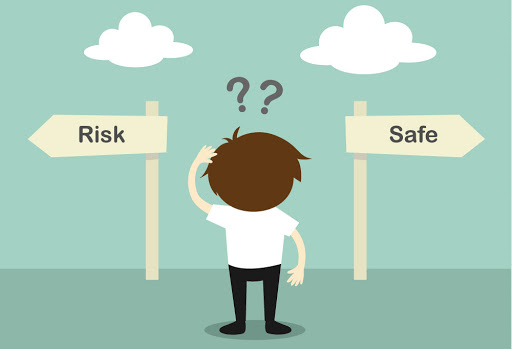4 TYPES OF RISKS IN BUSINESS

Koteswara Rao VBSS

The term business risk refers to the possibility of the occurrence of inadequate profits or losses for a commercial business due to uncertainties or unexpected events that are beyond control. In other words, anything that threatens a company’s competency to meet its target or achieve its financial goals is called Business risk. The degree of business risk depends upon the nature and size of the business. While the occurrences of risks are unpredictable, a company may not be able to shelter itself from risk completely. There are ways that a business can safeguard itself from the effects of business risk, primarily by adopting a risk management strategy.
For designing such a strategy of risk management, one needs to know “what are the factors due to which business risk occurs?” and “what are the types of risks that a business is likely to face?” The following information will give an insight into the above 2 questions.
- FACTORS CAUSING BUSINESS RISK: – Business risk is influenced by several factors such as:
1. Consumer tastes & preferences, likes & dislikes
2. Demand for the product and sales volume
3. Price per unit and input cost of the product
4. Prevailing degree of competition for the product
5. The complete economic condition
6. Government rules and regulations
7. Climatic effects and natural disasters
8. Wastage of resources whether it might be human or capital or natural
9. Damage of assets or obsolete mechanisms
10. Inappropriate human behaviours towards the organization. - TYPES OF BUSINESS RISKS: – The business risk can be mainly categorized into 4 types. They are: –
1. STRATEGIC RISK
2. OPERATIONAL RISK
3. FINANCIAL RISK
4. COMPLIANCE RISK
1. STRATEGIC RISK : – As the name itself indicates, the strategic risk arises when a business concern doesn’t operate according to the business strategy or model or plan. A business strategy becomes inefficient and less effective over time as a result it struggles to reach its defined goals. The strategic risk will occur in pursuit of the following things.
● Unsuccessful business plans
● By making poor business decisions
● From the substandard or inappropriate execution of decisions
● From the inadequate allocation of resources
● From failure to respond well to the changes that are taking place in the business environment.
2. OPERATIONAL RISK : – Operational risks for a business concern is the prospect of loss resulting from the inappropriate or failed procedure, systems, or policies of the business organization. This overarching operational risk may lead to the dissolution of the business concern. The things that may cause operational risk are:
● employee errors
● system failures
● fraud or other criminal activities
● any event that disrupts the business processes.
3. FINANCIAL RISK: – Financial risk generally relates to the odds of losing money and arises due to inadequate cost of capital, inappropriate financial transactions, growth capitalization issues, and Bank support. The common forms of this financial risk are credit risk, liquidity risk, asset-backed risk, foreign investment risk, equity risk, working capital risk, and currency risk. However, there are some common methods for analyzing these financial risks. They are:
● Fundamental analysis of securities intrinsic value
● Technical analysis for evaluating the securities through statistics
● Quantitative analysis for evaluating the historical performance of a business concern by using specific financial ratio calculations and ratio analysis.
A business organization with a higher amount of financial risk should choose a capital structure with a lower debt ratio to ensure that it can meet its financial obligations at all times. When the revenue drops, the organization may not be able to pay its debts which leads to bankruptcy on one hand and damage of reputation on the other hand. By taking a capital structure with a lower debt ratio, when the revenues of an organization increase it experiences larger profits and will be able to keep up with its obligations.
4. COMPLIANCE RISK: – This compliance risk arises in industrial sectors and businesses which are highly regulated with laws. For example – The wine industry must adhere to a 3-tier system od distribution, where a wholesaler is required to sell wine to a retailer, who in turn sells it to customers. Here, Wine sellers cannot sell directly to retail stores.
HOW TO OVERCOME RISKS IN BUSINESS: –
Here are some tips for avoiding the occurrences of risks in a business organization: –
1. Develop a solid business plan
2. Keep an eye on quality control tests
3. Habituate maintaining good records
4. Limit your business loans
5. Keep you accounts receivables low
6. Prepare yourself with insurance for those risks which can be compensated with the insurance policy
7. Save money in the form of reserves for future uncertain contingencies.
By knowing what are the types of risks, what are the factors that are causing business risks, and how to overcome or avoid risks in business one can excellently run his business by paving his/her way for profits.